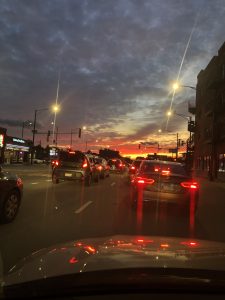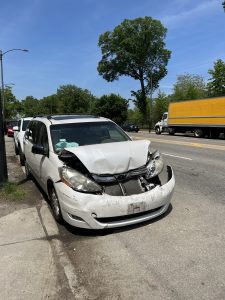The NHTSA did a groundbreaking study in 2008 to analyzed the cause of auto accidents. This study conducted by the University of Michigan closely studied 6,950 crashes using sensors and video cameras. From this study the researchers identified six major causes of car crashes. The findings were highlighted in an article entitled “Anatomy of a Car Crash” in Slate, November 21, 2017.
Right Turns on Red
The personal injury lawyers of Zneimer & Zneimer P.C. highlighted the dangers of right turns on red in a blog dated February 15, 2025. The dangers from right turns on red stem from the natural behavior of a driver who is engaging in a right turn on red. When a person pulls up to a red light with the intention of making a right turn, the driver’s attention is focused to the left to see if any cars are coming from that direction. If a car is coming from the left but is far enough away that the right on red can completed, the average driver proceed into the right turn while still being mindful of any cars coming from the left. What happens is the driver then fails to check for pedestrians crossing from the right or any bicyclist coming from the right. A U.S. Department of Transportation study found that pedestrian being hit by cars rose 43% to 107% after permissive right on right laws were implemented. Whats even worse, the NHTSA reports that rolling right on red accidents account for 6 percent of pedestrian deaths and sadly, 21% of these deaths are children. It is easy to see why cities like New York and San Francisco have banned right on red in most of their downtown.
Drowsiness
Almost everyone has probably driven while sleepy. We do everything we can to stay awake and it may not be enough. Coffee does not always do the job. The only thing we can do is pull over and try to to a nap to see if that works but that is not always possible if the is nowhere safe to park. Not surprisingly, about 7% of car crashes and 21% of fatal car crashes are caused by sleepy drivers according to the Slate article.
How to prevent drowsiness and falling asleep while driving depends on the individual. First, it is wise to avoid driving late at night or driving after a big meal if you know those things cause you to fall asleep. Always have coffee or an energy drink ready to help stay awake. Finally, if it is clear that you can not stay awake and are a danger, either stop for the night or at least pull over somewhere safe to take a nap in the car.
Loss of Control
Loss of control accounts for 11 percent of all crashes. These accidents include driving too fast for conditions, driving too fast around corners or losing control making a emergency maneuver. Too avoid losing control of your vehicle could be a matter of just slowing down. We have all seen people driving the regular speed limit even when it is raining and even when the roads are slick and icy. This type of driving is just inviting an accident due to losing control.
Blind Spot Accidents
What do you do when you are coming from a side street and are attempting to pull on to a main road except a truck or large SUV blocking your vision of on coming traffic. All you can do is inch out to get a slightly better view then gas it and hope there is no one coming. Or the situation where you are changing lanes and look in your rear view mirror and see no cars but as you beginning changing lanes you hear a loud horn of the car that was in your blind spot. The study found that 12% of accidents occur from situations like these. Recent technologies have greatly aided drivers in this regard. Most all new cars are now equipped with rear back-up cameras and most new cars are equipped with sensors on their rear-view mirrors that indicate if there is another vehicle in the blind spot.
Rear-Enders
This is perhaps the most common accident that the personal injury lawyers of Zneimer & Zneimer P.C. handles. These crashes range from minor fender benders to fatal accidents. According to the study between 23% and 30% of all crashes. From first hand experience from doing depositions, the major cause of these crashes is distraction and lack of attention. This includes cell phone distractions, passenger distractions or just “zoning out”. Drowsiness can be a major cause of loss of attention also. One way to help prevent this type of accident is to leave lots of room between your vehicle and the vehicle in front.
Distracted Lane Drifting
A surprising 33% of accidents in this survey were caused by drivers drifting out of their lanes. distraction again plays a big part of why this occurs. Either a driver is distracted by his cell phone, distracted by passengers, is drowsy and is having problems staying awake or is just day dreaming. New technology may have a cure. Many new cars have alarms now to indicate if a driver is drifting out their lane. This technology is especially effective for drivers who are falling asleep and leaving their lane.
Technology can be a great aid in help reducing many of the common causes of accidents but technology can only help so much. It is up to the driver to always pay full attention while driving to prevent accidents and serious injuries.
 Chicago Accident Lawyer Blog
Chicago Accident Lawyer Blog



